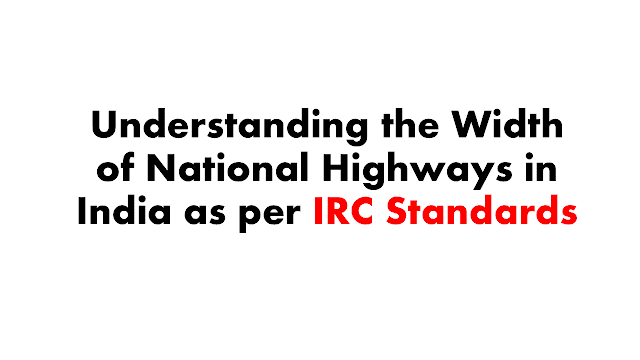Introduction
India's road network is the backbone of its economy, connecting diverse regions and facilitating the movement of goods and people across the nation. Among these roads, National Highways play a crucial role. Though they constitute only 2.7% of the total road network, they carry about 40% of the country's road traffic. These highways are regulated and administered by the Ministry of Road Transport and Highways, with specific standards set by the Indian Road Congress (IRC). This blog post delves into the width specifications of National Highways in India as per the IRC standards.
What is the IRC?
The Indian Road Congress (IRC) is the apex body that sets the guidelines for the design, construction, and maintenance of roads in India. It plays a pivotal role in ensuring that highways are built to meet the country's evolving needs, with standards that are periodically reviewed and updated to incorporate new technological advancements.
Why is the Width of National Highways Important?
The width of a National Highway is a key factor that influences its capacity, safety, and efficiency. An appropriately designed highway with adequate width can accommodate more traffic, reduce congestion, and lower the risk of accidents. Additionally, well-planned widths facilitate future expansions, which are increasingly necessary due to the rapid growth of vehicular traffic in India.
Standard Widths of National Highways
The width of National Highways in India varies depending on the number of lanes. The IRC standards specify not only the carriageway width (the portion of the highway used by vehicles) but also the shoulder width, median width, and right of way (RoW). The RoW includes the total land area acquired for the highway, providing space for future expansion.
Here’s a detailed breakdown of the typical widths as per IRC standards:
| Type of Highway | Right of Way (RoW) | Carriageway Width | Shoulder Width | Median Width | Future Expansion Area |
|---|---|---|---|---|---|
| 2-Lane Highway | 30 meters (100 feet) | 7 meters (23 feet) | 2.5 meters (8.2 feet) on each side | N/A | 18 meters (59 feet) |
| 3-Lane Highway | 30 meters (100 feet) | 10.5 meters (34 feet) | 2.75 meters (9 feet) on each side | N/A | 14 meters (46 feet) |
| 4-Lane Highway | 45 meters (150 feet) | 14 meters (46 feet) | 4 meters (13 feet) on each side | 5 meters (16 feet) | 18 meters (59 feet) |
| 6-Lane Highway | 60 meters (200 feet) | 21 meters (69 feet) | 3.5 meters (11.5 feet) on each side | 5 meters (16 feet) | 27 meters (89 feet) |
| 8-Lane Highway | 75 meters (250 feet) | 28 meters (92 feet) | 4.5 meters (15 feet) on each side | 7 meters (23 feet) | 31 meters (102 feet) |
Key Components Explained
Carriageway Width: This is the portion of the highway used by vehicles. The width varies based on the number of lanes, with each lane typically being 3.5 meters wide. For example, a 2-lane highway has a carriageway width of 7 meters, while an 8-lane highway has a width of 28 meters.
Shoulder Width: The shoulders are provided on either side of the highway for emergency stops and to support the pavement laterally. Their width increases with the number of lanes, ranging from 2.5 meters on a 2-lane highway to 4.5 meters on an 8-lane highway.
Median Width: The median separates opposing streams of traffic, reducing the risk of head-on collisions. The width of the median varies between 5 to 7 meters, depending on the highway.
Right of Way (RoW): RoW encompasses the total land area acquired for the highway, including the carriageway, shoulders, median, and space reserved for future expansions. The RoW for a 2-lane highway is typically 30 meters, while for an 8-lane highway, it is 75 meters.
Why Consider Future Expansion?
Given the rapid increase in vehicular traffic in India, it's essential to design highways that can accommodate future expansions. The RoW is often planned with extra space to allow for the addition of more lanes, parking areas, footpaths, and other facilities as required. This foresight helps prevent the challenges associated with land acquisition and highway redesign in the future.
Thumb Rules for Highway Design
Lane Width: Always consider a standard lane width of 3.5 meters.
Shoulder Width: Highways with more than 2 lanes should have wider shoulders to enhance safety.
Right of Way (RoW): Ensure that the RoW is adequate for future expansion, especially on major highways.
Conclusion
The design and construction of National Highways in India are governed by the stringent guidelines set by the IRC. These standards ensure that highways are built to accommodate current traffic while being prepared for future growth. Understanding the typical widths of National Highways and their components is crucial for professionals involved in highway engineering, construction, or maintenance. As India's road network continues to evolve, adhering to these standards will be essential in maintaining the efficiency, safety, and sustainability of the nation's highways.







0 Comments